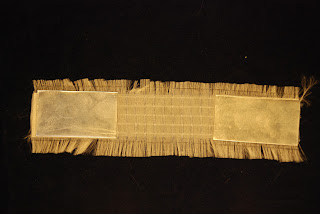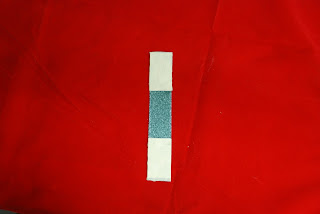In my final post for my senior project I would like to thank everyone who made this project possible as well as a great learning experience.
First I would like to thank Dr. Barzin Mobasher for letting me intern with his team on such short notice as well as Luca Alfarano, Himai Mehere, and Jacob Bauchmoyer for answering every one of my many questions and allowing me to assist them in their research. Being able to work in such a research oriented setting was a brand new experience for me and I am very thankful to have had the opportunity.
Next I would like to thank my senior project advisor Daniel Deluzio. He has really motivated me to pursue my passion in Astronomy through his Astrophysics class. I also want to thank him for accepting to be my project advisor even when he had little knowledge in material science, he did not hesitate in his answer and claimed it would be "a learning experience for both of us."
I would like to thank my college counselors, Mrs. Kate and Mrs. Q, for making this project possible, without them I would've probably sat around everyday for the last 4 months.
I would also like to thank my Head of School Mr. Villafuerte for getting me back on track with my project when the senioritis hit me towards the end of the year. I really appreciate him being there and continuing to motivate me everyday.
Lastly, I would like to thank Ms. Rubio. Even though she did not have the largest role throughout my project, she was definitely the biggest reason why I finished it in the first place. If I didn't have her threatening to take tickets for Ed Sheeran's concert away from me I probably would've given up just before the finish line... I definitely would've regretted not finishing if I would've stopped the project.
Thanks to everyone who frequently tuned into my blog,
Thanks for reading,
Nick Thompson
Tuesday, May 16, 2017
Saturday, May 13, 2017
Static Testing Nylon Samples
Today I helped Luca out with tests he ran on his nylon samples. We used the static test machine to bring the samples to failure then recorded the point of failure. It was pretty cool to see the consistency of the material while also observing the slight differences between each individual sample. As every sample was exposed to different levels of stress and therefore is deformed in a different way than every other sample.
Tomorrow is my last day interning at ASU so I will make a post thanking everyone. Until then here are some pictures from the static testing today.
Tomorrow is my last day interning at ASU so I will make a post thanking everyone. Until then here are some pictures from the static testing today.
Thanks for reading,
Nick Thompson
Wednesday, May 10, 2017
Testing More Nylon
Tomorrow we will be testing more nylon samples except these samples were not provided by NASA, there were cut from sheets of nylon at ASU. Luca, the exchange student from Italy, will be testing these samples on the static test machine to hopefully gain a better understanding of the nylon and use the results for his paper. I will post pictures of the tests tomorrow and talk about the tests as well.
Thanks for reading,
Nick Thompson
Thanks for reading,
Nick Thompson
Thoughts on Testing
While getting everything in order to start testing the samples took like three months... I really enjoyed watching the samples get ripped in half once testing started. Analyzing the points of failure of the samples and the maximum amount of stress the sample of nylon can withstand before failing. I thought it was really cool to see how the graduate students showed trends in data and analyzed the results. I had never seen how data was actually analyzed to show trends rather than just showing the raw results of the experiment, so observing this was a new experience.
That's all for high-speed testing, hopefully later this week we will test Luca's project samples for his personal paper.
Thanks for reading,
Nick Thompson
That's all for high-speed testing, hopefully later this week we will test Luca's project samples for his personal paper.
Thanks for reading,
Nick Thompson
Friday, May 5, 2017
We Finally Got to Rip up the Samples
Today was a big day. All our hard work and anticipation put into preparing the samples and waiting on the machine to be fixed was finally put to use. We successfully tested 10 NASA provided nylon samples on the high-speed test machine and are now able to analyze the data through our DIC results. I am very excited to see how the test results show up as these results will go directly to NASA to help them get a better understanding of why the fabric ripped on the last test and what types of stress and strain the fabric can withstand.
Here is a picture of some of the samples post-testing:
Thanks for reading
Nick Thompson
Here is a picture of some of the samples post-testing:
Thanks for reading
Nick Thompson
Its a Miracle
After a few days of fixing, the High-speed test machine finally started working again. We will be running tests in the upcoming days however I feel the need to commemorate the hard working ASU technicians who continually put up with that 15 year old machine. It must be bi-polar or something... or going through a phase, I'm pretty sure thats what teenagers do. Anyways I'll post a couple pictures of what the high-speed test machine looks like.
Thanks for reading
Nick Thompson
An Unfortunate Turn of Events
So... The thing I joking said in the last blog post about the high-speed test machine not working came true. The machine was working perfectly yesterday but decides not to work on the day we were supposed to test the NASA nylon samples. On a related note, I had to prepare another 10 samples of the nylon given to ASU by NASA. I learned that each square inch of the fabric is worth $100... meaning that I held fabric that was worth more than I am.
Hopefully the machine gets fixed and we are able to test soon.
I have a few pictures of some NASA nylon samples:
Thanks for Reading.
Nick Thompson
Hopefully the machine gets fixed and we are able to test soon.
I have a few pictures of some NASA nylon samples:
Thanks for Reading.
Nick Thompson
Static-Stress Testing
To begin this week I helped run static stress tests on the samples I prepared last week. The static-stress test machine differs from the high-speed stress machine in that it slowly applies a load onto the sample until failure. The high-speed stress machine rapidly applies a load onto the sample resulting in failure of the material.
Each test takes anywhere from five to ten minutes per sample, so we were performing tests for well over two hours. Seeing the machines functioning and performing the tests was a new experience for me as I have never actually performed tests with machinery in a lab setting.
However, in order to properly take data of the samples a system called DIC had to be set up to analyze any deformation of the sample through the application of the load. DIC setup takes about three hours alone as the process is very precise and detailed.
My next post will contain testing on the high-speed machine... unless it stops working.
Here are a few pictures of the Static tests and of the DIC set up:
Thanks for reading.
Nick Thompson
Each test takes anywhere from five to ten minutes per sample, so we were performing tests for well over two hours. Seeing the machines functioning and performing the tests was a new experience for me as I have never actually performed tests with machinery in a lab setting.
However, in order to properly take data of the samples a system called DIC had to be set up to analyze any deformation of the sample through the application of the load. DIC setup takes about three hours alone as the process is very precise and detailed.
My next post will contain testing on the high-speed machine... unless it stops working.
Here are a few pictures of the Static tests and of the DIC set up:
Thanks for reading.
Nick Thompson
Preparing Samples for High-speed stress testing
For the last few days at ASU I have been preparing nylon samples which will be used for testing on the High-speed stress machine. To properly prepare the samples I have had to pull the nylon, yarn by yarn, until the sample was the proper width and length and could fit in the grips of the machine. I believe I prepared 20 or so samples for next week's tests. Yes this process is as tedious and as mentally challenging as it sounds, however I am beginning to understand that this feeling is a large part of what I considered "science."
Hopefully we can start testing these samples next week and watch our hard work get ripped to shreds..
Here are a couple pictures of samples I prepared.
Hopefully we can start testing these samples next week and watch our hard work get ripped to shreds..
Here are a couple pictures of samples I prepared.
Thanks for reading
Nick Thompson
Thursday, May 4, 2017
High-Speed Test Machine
ASU technicians and lab managers have finally made the high-speed test machine fully functional after being out of use for nearly a decade. The machine was missing several key components that needed to be replaced. The machine is now safely able to test various samples by rapidly applying stress loads to them, simulating stress the sample would experience at high speeds due to air resistance. In particular, Dr. Mobasher and his team are now able to fully test nylon samples provided by NASA to collect and analyze how the samples react to rapidly applied stresses. The nylon must be able to withstand the stresses an object would undergo at speeds of Mach 2 or lower after the supersonic inflatable decelerators are finished slowing the payload.
My next post will pertain to preparing nylon samples and further tests that will be run.
Thanks for reading,
Nick Thompson
Subscribe to:
Comments (Atom)













